[This information guide is also available as a PDF to download.]
General advice on exercise and regaining shoulder function
The exercises shown in this brochure should be used as a guide. Other exercises may be recommended by your physiotherapist or doctor.
Always do the exercises within comfort limits. Stiffness of the shoulder may occur after breast or armpit (axillary) surgery. It is therefore important you regain full use of your shoulder as soon as possible after your operation.
This can be done with a combination of exercise, massage and by using your arm normally for daily activities at home and at work.
Stretching or pulling in your armpit with exercise is quite normal. If you are experiencing significant pain whilst doing these exercises, speak to your physiotherapist, breast care nurse or doctor.
Exercises to start the day after surgery
These exercises are for ALL patients.
They are appropriate for the first 7 days after surgery, or until your first doctor’s appointment.
Physical Activity After Surgery
After surgery, it is important to get out of bed and start walking daily. Remember when walking, keep an upright posture and relax your arms down by your side. Walking should become part of your daily routine.
- Complete each of the following exercises five times.
- Repeat the exercise program four times a day.
Exercise 1
Coughing exercises are important after you have an anaesthetic
Take 5 deep breaths in through your nose and breathe out through your mouth, then breathe in and cough supporting the surgical site with the palm of your hand or a small pillow.
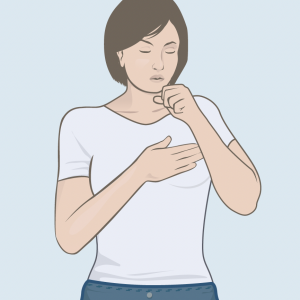
Exercise 2
a). Bend and straighten your elbow, then
b). Open and close your hand,
c). Move your wrist backwards and forwards,
d). Place your palm face up and palm face down,
e). Bend and straighten your elbow again.
Repeat this exercise 5 times.
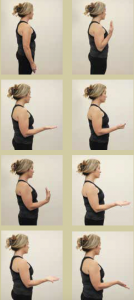
Exercise 3
Squeeze your shoulder blades together gently and then release.
Repeat this exercise 5 times.
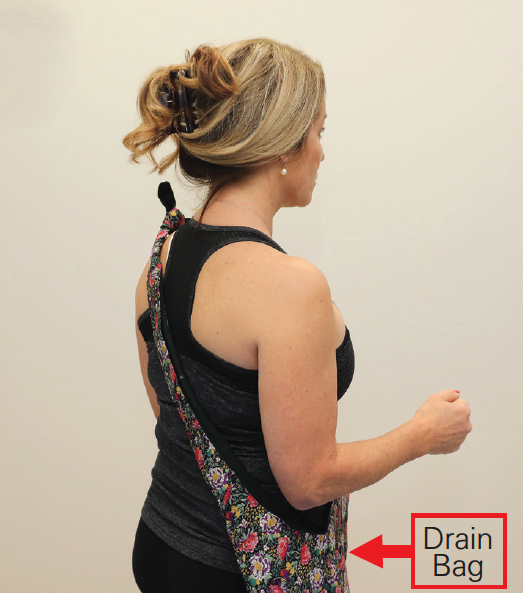
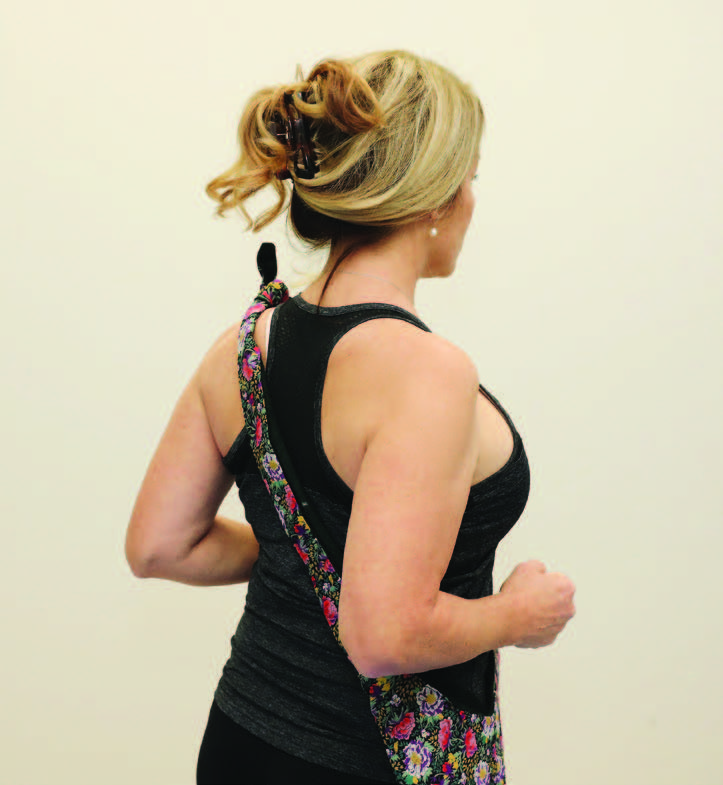
Exercise 4
a). Stand with your elbows bent at your side.
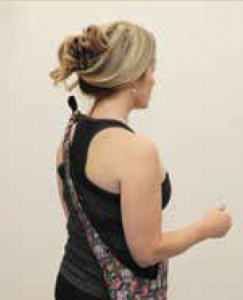
b). Roll your shoulders backwards.
Repeat this exercise 5 times.
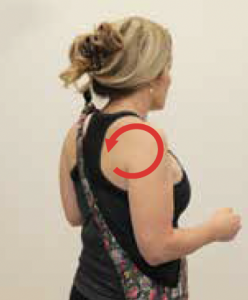
Exercise 5
a.) With your arm resting by your side.
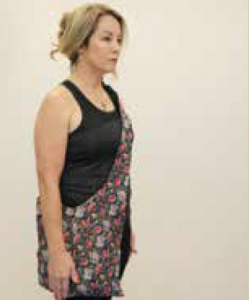
b) Keeping your elbow straight, move your arm up in front of you to shoulder height. Return your arm to the resting position.
Repeat this exercise 5 times.
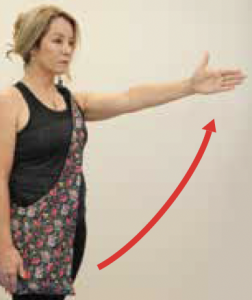
Exercise 6
a) With your arm resting by your side.
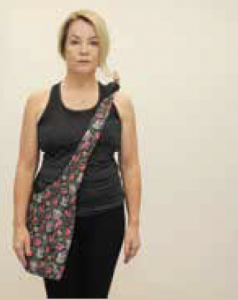
b) Keeping your elbow straight, move your arm out to the side to shoulder height. Return your arm to the resting position.
Repeat this exercise 5 times.
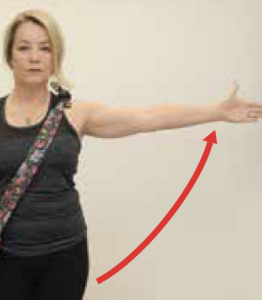
The following exercises are safe if you DO NOT have a drain, OR once your drain has been removed.
These photos show the full range of the movement in the exercise. It may take you a number of weeks to be able to achieve your full range of movement.
You should continue with these exercises every day for 6 to 12 months.
Exercise 7
a) Stand facing the wall with your arm out straight.
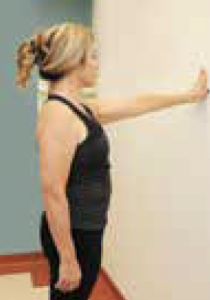
b) Gradually walk your fingertips up the wall until you feel a comfortable stretch. You need to move closer to the wall as your hand reaches higher.
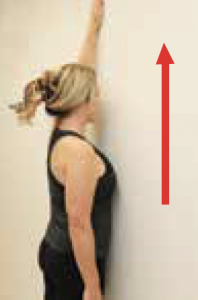
c) Turn your body away from the wall until you feel an increase in stretch across your chest and armpit. Keep your hand on the wall as you hold this position for 5 seconds while you continue to take slow breaths, then turn back to face the wall to reduce the stretch. Slowly return your arm to rest by your side.
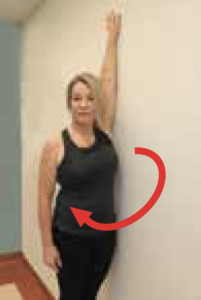
Repeat this exercise 5 times.
Exercise 8
a) Stand side-on to the wall with your arm straight.
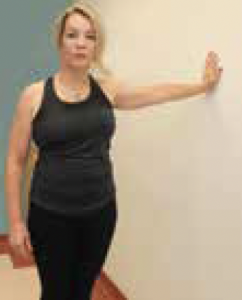
b) Gradually walk your fingertips up the wall until you feel a comfortable stretch. You need to move closer to the wall as your hand reaches higher.
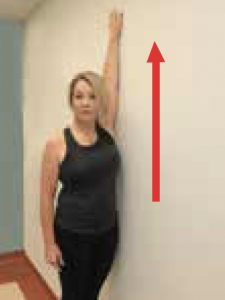
c) Turn your body away from the wall until you feel an increase in stretch across your chest and in the armpit. Keep your hand on the wall as you hold this position for 5 seconds while you continue to take slow breaths. Slowly return your arm to rest by your side.
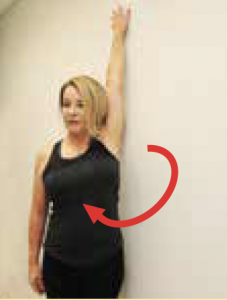
Repeat this exercise 5 times.
Exercise 9
a) Lie on the bed and place your hands behind your head with elbows straight out in front of you.
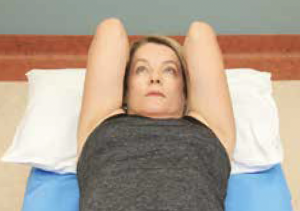
b) Gently try and bring your elbows out to the side and down towards the pillow. Hold this position for 5 seconds. Return your arms to the starting position.
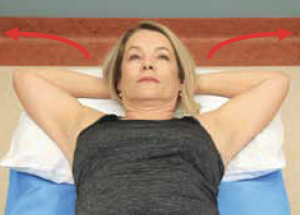
Exercise 10
a) Lie on the bed, holding a stick with your arms down by your side.
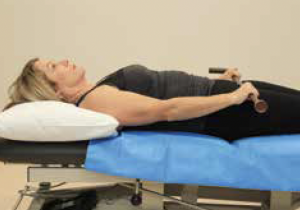
b) With your elbows straight slowly lift both arms up to bring the stick over your head. Return your arms to the starting position.
You can use a walking stick or umbrella to complete this exercise.
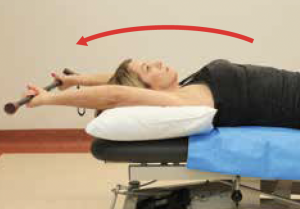
Massage of the underarm (Axilla)
Massage of the underarm if you have had surgery of the axilla is important to reduce swelling and pain.
It is normal after axilla surgery to feel shooting pain, burning pain, or nerve pain in this area. The below massage technique will help to alleviate these symptoms.
This can be started around 2-3 days. This should be done for 1-2 minutes per day.
Using a lotion or oil will help make massage easier. Massage around your dressing to avoid the dressing falling off.
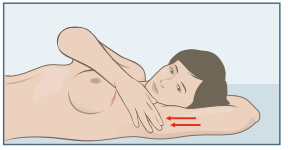
Figure 12 Massage of the scar
Massage of the arm
Using the flat of your hand and with a constant pressure massage from the elbow to the armpit. After a few days you may be able to start to massage further into the armpit and across to the chest. This can be started a few days after your operation and continued each day.
Massage of your scars after the dressings are removed
Massaging your surgical scars when all your dressings have been removed and after the first stages of healing has occurred helps prevent excess scar tissue forming and will help alleviate pain and sensitivity.
Using a lotion or oil will help make massage easier.
It is recommended you complete scar massage when all dressings have been removed or around 3 weeks after surgery for 2 minutes daily. This can be continued for 6 – 12 months after surgery.
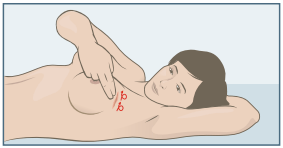
Figure 11 Massage of the scar
Massage of the scar
Using the flat of your fingers and with a constant pressure move your fingers in a circular motion across the scar. Commence the movement at the outer edge of the scar, moving towards the inside. The scar may be sensitive at first, but will become less tender with daily massage.
Useful Contacts / Websites
| Cancer Australia | canceraustralia.gov.au |
| Cancer Council | cancer.org.au |
| Cancer Council Helpline | 13 11 20 |
| Breast Cancer Network Australia (BCNA) | 1800 500 258 bcna.org.au |
[This information guide is also available as a PDF to download.]
Version 9 – WSP 206 August 2024
© Westmead Breast Cancer Institute 2024
